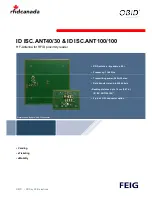
Weitere Unterlagen
Ergänzend zu diesem Dokument finden Sie im Inter-
net unter
www.turck.com
folgende Unterlagen:
■
Datenblatt
■
Betriebsanleitungen der excom®-Betriebsmittel
■
Handbuch
■
Zulassungen
Zu Ihrer Sicherheit
Bestimmungsgemäße Verwendung
Die Geräte sind ausschließlich zum Einsatz im indus-
triellen Bereich bestimmt. Das excom®-I/O-System
ist ein zugelassenes Betriebsmittel für den Einsatz im
Ex-Bereich, Zone 1 und 21. Der Betreiber darf nur die
in Tabelle 3 aufgeführten Betriebsmittel ohne weitere
Zulassung einbauen. Vor der Inbetriebnahme muss
der Betreiber einen Temperaturnachweis erbringen.
Die Geräte dürfen nur wie in dieser Anleitung
beschrieben verwendet werden. Jede andere
Verwendung gilt als nicht bestimmungsgemäß. Für
daraus resultierende Schäden übernimmt Turck keine
Haftung.
Allgemeine Sicherheitshinweise
■
Nur fachlich geschultes Personal darf das excom®-
I/O-System montieren, installieren, betreiben,
parametrieren und instand halten.
■
Die Geräte erfüllen ausschließlich die EMV-Anforde-
rungen für den industriellen Bereich und sind nicht
für den Einsatz in Wohngebieten geeignet.
Hinweise zum Ex-Schutz
■
Bei Einsatz des Geräts im Ex-Bereich muss der
Anwender zusätzlich über Kenntnisse im Explosi-
onsschutz (EN 60079-14 etc.) verfügen.
■
Nationale und internationale Vorschriften für den
Explosionsschutz beachten.
■
Das Gerät nur innerhalb der zulässigen Betriebs-
und Umgebungsbedingungen (siehe Zulassungs-
daten und Auflagen durch die Ex-Zulassung)
einsetzen.
■
Nicht benutzte Leitungseinführungen durch Ver-
schlussstopfen verschließen.
■
Gehäuse nur kurzzeitig zu Service- und Wartungs-
zwecken öffnen.
■
Betriebsanleitungen der eingebauten Betriebsmit-
tel beachten.
Produktbeschreibung
Geräteübersicht
siehe Abb.1: Abmessungen, Abb. 6: Frontansicht in
Einbaulage
Funktionen und Betriebsarten
Die excom®-I/O-Systeme bestehen aus einem
Edelstahlgehäuse der Zündschutzart Gehäuse Ex „tb“
oder Ex „e“ mit integriertem Modulträger. Der Modul-
träger kann mit verschiedenen excom®-I/O-Modulen
bestückt werden. Je nach Ausführung sind andere
zum Betrieb benötigte Vorschalt- sowie Steuer- und
Regelkomponenten herstellerseitig eingebaut.
DE
Kurzanleitung
Montieren
GEFAHR
Explosionsfähige Atmosphäre
Explosionsgefahr durch heiße Oberflächen!
➤
➤
➤
Vor der Inbetriebnahme sicherstellen, dass die
zulässige Betriebstemperatur des excom®-I/O-
Systems nicht überschritten wird.
Keiner direkten Sonneneinstrahlung aussetzen.
Vor der Bestückung des excom®-I/O-Systems und
jeder Änderung der Bestückung einen schriftli-
chen Temperaturnachweis durchführen.
Für die Bestückung ausschließlich die in Tabelle 3
genannten I/O-Module verwenden.
Keine zusätzlichen Leistungen in das Gehäuse
einbringen.
Temperaturnachweis durchführen
Der Betreiber muss vor der ersten und jeder Änderung
der Bestückung schriftlich nachweisen, dass die
Betriebstemperatur des excom®-I/O-Systems bei der
maximal möglichen Umgebungstemperatur nicht
überschritten wird. Ein erfolgreich geführter Tempe-
raturnachweis ist Bestandteil der Anlagendokumen-
tation, die der Betreiber bereitstellen muss.
➤
➤
Maximal mögliche Umgebungstemperatur ermit-
teln, die am Montageort des excom®-I/O-Systems
auftreten kann, und in Tabelle 3 eintragen.
➤
➤
Auf dem Typenschild des Systemgehäuses in der
Tabellenspalte T
amb
[°C] den passenden Tempera-
turbereich wählen.
➤
➤
Auf dem Typenschild den Wert der maximal zuläs-
sigen Gesamtverlustleistung P
admissible
auswählen,
der dem gewählten Temperaturbereich entspricht.
➤
➤
Maximal zuässige Gesamtverlustleistung P
admissible
der Module in Tabelle 3 eintragen.
➤
➤
Pro Modultyp: Anzahl der vorgesehenen Module in
Tabelle 3, Spalte n
module
, eintragen.
➤
➤
Pro Modultyp: Leistung P
module
mit der Anzahl
n
module
multiplizieren und das Ergebnis in Tabelle 3,
Spalte P
total
, eintragen.
➤
➤
Werte der Spalte P
total
addieren und Summe
Σ (P
total
) in Tabelle 3 eintragen.
➤
➥
Falls Σ (P
total
) ≤ P
admissible
: Der Temperaturnachweis
ist erfolgreich erbracht, d. h. die Gesamtverlust-
leistung der Module ist kleiner oder gleich der
zulässigen Gesamtverlustleistung. Die vorgesehe-
nen Module dürfen eingebaut werden.
➤
➤
Temperaturnachweis in die Anlagendokumenta-
tion aufnehmen.
➤
➥
Falls Σ (P
total
) > P
admissible
: Der Temperaturnachweis
ist nicht erfolgreich erbracht, d. h. die maximale
Gesamtverlustleistung der Module überschreitet
die zulässigen Gesamtverlustleistung.
➤
➤
Anzahl der Module reduzieren.
➤
➤
Temperaturnachweis wiederholen.
Beispiel für den Temperaturnachweis (Tabelle 4)
Voraussetzungen:
■
Umgebungstemperatur am Montageort des
excom®-I/O-Systems max. 48 °C
■
P
admissible
≤ 22 W für T
amb
-20...+50 °C gemäß Typen-
schild am Gehäuse (siehe Tabelle 2)
■
Der Temperaturnachweis muss für P
admissible
≤ 22 W
durchgeführt werden.
■
10 Module sollen in das Systemgehäuse eingebaut
werden
Ein erfolgreich durchgeführter Temperaturnachweis
ist in Tabelle 4 beschrieben: Die vorgesehenen Modu-
le erreichen eine maximale Gesamtverlustleistung von
20,2 W. Damit ist der Temperaturnachweis für P
admissible
(max. 22 W) erfolgreich erbracht.
IO-System excom® – EG-VA655526/***-****/2GD60.*****
Other Documents
Besides this document the following material can be
found on the Internet at
www.turck.com
:
■
Data sheet
■
Operating instructions for excom® equipment
■
Manual
■
Approvals
For Your Safety
Intended Use
These devices are designed solely for use in industrial
areas. The excom® I/O system is approved for use in
hazardous areas, Zones 1 and 21. The operator may
only install the equipment listed in Table 3 without
further approval. Before commissioning, the operator
must provide proof of temperature.
The devices must only be used as described in these
instructions. Any other use is not in accordance with
the intended use. Turck accepts no liability for any
resulting damage.
General Safety Instructions
■
The excom® I/O system may only be assembled,
installed, operated, parameterized and maintained
by professionally trained personnel.
■
The devices only meet the EMC requirements for
industrial areas and are not suitable for use in
residential areas.
Notes on Ex Protection
■
When operating the device in a hazardous area, the
user must also have a working knowledge of explo-
sion protection (EN 60079-14, etc.).
■
Observe national and international regulations for
explosion protection.
■
Only use the device within the permissible operat-
ing and ambient conditions (see certification data
and Ex approval specifications).
■
Seal unused cable entries with sealing plugs
■
Only open the housing for a short period of time to
perform service and maintenance tasks.
■
Observe the operating instructions of the installed
equipment.
Product Description
Device Overview
See Fig. 1: Dimensions, Fig. 6: Front view in the instal-
lation position
Functions and Operating Modes
The excom® I/O systems consist of a stainless steel
housing from explosion protection category Ex “tb”
or Ex “e” with an integrated module rack. The module
rack can be equipped with various excom® I/O mod-
ules. Depending on the version, other upstream and
control components that are required for operation
may be installed by the manufacturer.
Installation
DANGER
Potentially explosive atmosphere
Explosion hazard due to hot surfaces!
➤
➤
➤
Before commissioning, ensure that the maxi-
mum permissible operating temperature of the
excom® I/O system is not exceeded.
Do not expose the system to direct sunlight.
Before equipping and every change of equip-
ment of the excom® I/O system, a written proof
of temperature must be provided.
Use only the I/O modules indicated in Table 3 for
configuration. Do not introduce any additional
power into the housing.
Providing Proof of Temperature
Prior to the first and every change of the equip-
ment, the operator must prove in writing that the
operating temperature of the excom®-I/O system
is not exceeded at the maximum possible ambient
temperature. Written proof of the temperature forms
an integral part of the plant documentation that the
operator must provide.
➤
➤
Determine the maximum possible ambient
temperature for the location in which the excom®
I/O system is installed, and enter this information
in Table 3.
➤
➤
Select the relevant temperature range in the T
amb
[°C] column using the nameplate on the system
housing.
➤
➤
Using the nameplate, select the value for the max.
admissible total power dissipation (P
admissible
) that
corresponds to the selected temperature range.
➤
➤
Enter the maximum admissible total power dissipa-
tion (P
admissible
) for the modules in Table 3.
➤
➤
For each module type: Enter the number of mod-
ules that you are intending to use in the n
module
column of Table 3.
➤
➤
For each module type: Multiply the power (P
module
)
by the number of modules (n
module
) and enter the
result in the P
total
column of Table 3.
➤
➤
Add the values in the P
total
column together and
enter the total in the Σ (P
total
) row of Table 3.
➤
➥
If Σ (P
total
) ≤ P
admissible
: The proof of temperature has
been successfully completed, i.e., the total power
dissipation of the modules is less than or equal to
the admissible total power dissipation. The mod-
ules that you are intending to use may be installed
➤
➤
Record the proof of temperature in the plant
documentation.
➤
➥
If Σ (P
total
) > P
admissible
: The proof of temperature has
been unsuccessful, i.e., the total power dissipation
of the modules exceeds the admissible total power
dissipation.
➤
➤
Reduce the number of modules.
➤
➤
Provide proof of temperature again.
Example Proof of Temperature (Table 4)
Prerequisites:
■
Max. ambient temperature at installation location
of the excom® I/O system is 48 °C.
■
P
admissible
≤ 22 W for T
amb
-20…+50 °C in accordance
with the nameplate on the housing (see Table 2).
■
The proof of temperature must be completed for
P
admissible
≤ 22 W.
■
10 modules need to be installed in the system
housing.
A successfully performed proof of temperature is
outlined in Table 4: The modules intended for use
reach a maximum total power dissipation of 20.2 W.
This means that the proof of temperature has been
successfully completed for P
admissible
(max. 22 W).
IO System excom® – EG-VA655526/***-****/2GD60.*****
© Hans Turck GmbH & Co. KG | 100001446 2018-10 DE EN | V1.3
Hans Turck GmbH & Co. KG | Witzlebenstraße 7, 45472 Mülheim an der Ruhr, Germany | Tel. +49 208 4952-0 | Fax +49 208 4952-264 | [email protected] | www.turck.com
EG-VA655526/***-****/2GD60.*****
550
650
260
505
685
ø 11
5
Type Label
T
amb
[°C]
P
admissible
[W]
-20…+40
≤ 55
-20…+45
≤ 38
-20…+50
≤ 22
-20…+55
≤ 6
P
total
(T
amb
≤ … °C )
Module Type
P
module
[W]
n
module
P
total
= P
module
[W] × n
module
AI41EX
2.0
AI401EX
2.2
AI43EX
1.5
AIH40EX
3.0
AIH401EX
3.0
AIH41EX
1.5
AO401EX
2.5
AOH40EX
3.0
AOH401EX
3.0
DF20EX
1.0
DI401EX
2.0
DM80EX
1.0
DO401EX
4.5
TI40EX
1.0
TI41EX
1.0
S (P
total
)
… W
P
admissible
… W
Example: P
total
(T
amb
≤ 48 °C )
Module Type
P
module
[W]
n
module
P
total
= P
module
[W] × n
module
AI41EX
2.0
1
2.0
AI401EX
2.2
1
2.2
AI43EX
1.5
AIH40EX
3.0
1
3.0
AIH41EX
1.5
1
1.5
AIH401EX
3.0
AO401EX
2.5
1
2.5
AOH40EX
3.0
1
3.0
AOH401EX
3.0
DF20EX
1.0
DI401EX
2.0
2
4.0
DM80EX
1.0
1
1.0
DO401EX
4.5
TI40EX
1.0
1
1.0
TI41EX
1.0
S (P
total
)
20.2 W
P
admissible
22.0 W
EN
Quick Start Guide





















